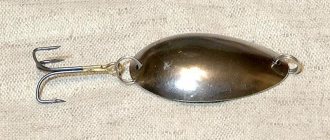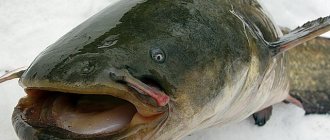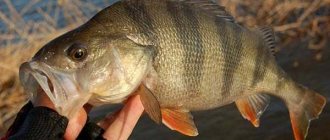The largest caught on the Volga and in Russia
In 1922, in the lower reaches of the Volga, the largest beluga fish ever caught was caught. In the photographs spread across the Internet, this same marine inhabitant is visible. It weighs, according to estimates, more than a ton (which is a clear record) - 1224 kg. Since the caught specimen was female, its eggs were also weighed. There were about 150 kg of black delicacy.
Beluga
Due to its enormous size, this fish received the nickname “king fish”. The largest individuals were caught back in the 19th century, when a record was officially documented - an individual weighing 1.5 tons. If we talk about modern history, the largest beluga was caught by fishermen in 1922 at the mouth of the Volga. The weight of the fish was 1224 kg, with a length of 4 meters.
Catching a trophy is the dream of many fishermen. We, in turn, wish you good luck in these endeavors and perhaps you will become the lucky one we will write about in the next article!
Lifestyle and life cycle
It belongs to the migratory fish species: in the deep sea it is found alone for feeding purposes, while it likes to spawn in schools in fresh, shallow rivers. Finding a sufficient amount of food in the seas, it dives to different depths (depending on the depth level of the organisms). Sturgeon live a long time, on average 40 years, but can live up to 100 years.
Belugas migrating during spawning are divided into two groups. The winter fish (its bright representative lives in the Caspian Sea) swims into large rivers in flocks in the autumn, the spring fish - in the spring. By itself it is a solitary fish.
Loves unpolluted sea spaces closer to the bottom. Warmth is one of the conditions for its habitat in a certain place. In cold seasons, she, having hunted enough, swims away into the hole she finds at the bottom. Covered in a layer of mucus, it goes into hibernation. With the help of such simple actions, the beluga survives the cold.

Zander
Pike perch is a predator, feeds on small fish and leads a secretive lifestyle. In places of active hunting, especially during the feeding process, it is not difficult to catch it. Due to its gluttony, it can be caught even by a novice fisherman. Pike perch is valued for its healthy dietary meat, containing a lot of protein.
This type of fish can be found not only in fresh lakes and rivers of Russia, but also in the seas: Black, Baltic, Azov, Caspian. Usually the weight of caught pike perch is 8-10 kg . However, there is a documented case of catching a fish weighing 22 kg. They also say that the largest pike perch was caught in the last century on the Volga River, its weight was 40 kg.
Description
Beluga has an impressive size and heavy weight. It can weigh up to a ton, but on average fish caught commercially reaches 200-300 kg. Very young individuals reach only 20-30 kg. They reach a length of about 4-5 meters. The massive body with a grayish-ash tint has large scales that do not overlap each other - this type is called ganoid. According to the description, both males and females do not have any special features in their scales that distinguish them by gender. The name of this underwater inhabitant from Latin is Huso huso, which means “pig”. The closeness to this animal can be seen by the snout-like shape of the head. The snout, similar to a snout, is blunt and short, and the mouth, limited by thick lips, has a crescent shape.
Small eyes cannot convey accurate information to the fish about the surrounding world - the beluga is blind. But her sensitive sense of smell helps her in her knowledge - through the antennae hanging from her upper lip.
From the photo you can see the appearance of these representatives - the underdeveloped bony scutes on the head and the bugs on the belly and back bear little resemblance to the usual scales of marine inhabitants; they look clearly distinguishable.
Burbot
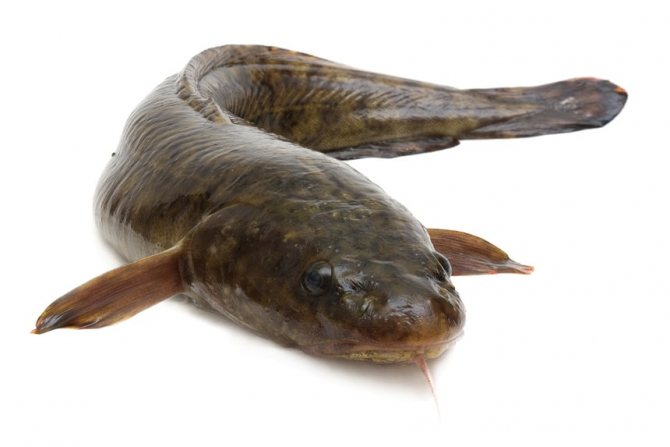
The largest representative of the species was caught in Siberia in 1967. Its weight was 30 kg and its length was 120 cm. Other cases were also recorded. 1985, Lake Onega, a burbot weighing 16 kg was caught. 1910, Lake Ladoga, a fish weighing 10 kg was caught. Catching such large burbot is an incredible success, because their average weight is 3-4 kg .
Interesting: The most beautiful seas in the world - list, description, photos and videos
Burbot is a northern fish. It loves cold water, so it rarely appears in the south. Lives in Siberian rivers and Lake Baikal. Also found in northern Europe: Finland, the Baltic states, and the Leningrad region.
Growth and reproduction
Males reach sexual maturity by 12-14 years, females become capable of reproduction a little later - by 18 years. In addition, females, in addition to a certain age, need to reach a weight of more than 50 kg.
Interesting! The Caspian beluga reaches sexual maturity at 27 years, which is much later than other representatives.
The breeding season occurs in April and May. Individuals ready for this period swim away from the seas into deep rivers with fast currents. Optimal temperatures for reproduction are considered to be 9-17 degrees. Spawning usually begins on days with maximum water levels in the river.
The eggs are deposited on a hard (preferably rocky) bottom, where the fast current will provide a continuous supply of oxygen. The required depth for throwing it is about 10-15 meters. The eggs, which become sticky after fertilization and attach to the bottom due to new properties, come out large. And how much caviar comes out at a time! The number varies from 200 thousand to 8 million. When the fry grow from the eggs, the female swims back to the sea with them. Such migration in adult fish can occur once every 2-3 years. They can spawn intermittently during their lives, on average, about 8-9 times. Occasionally, adult fish die after spawning.
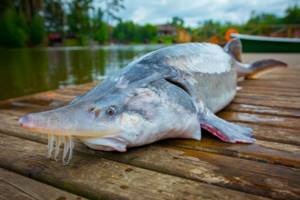
Sometimes beluga breeds with its relatives - sterlet, stellate sturgeon, thorn. As a result, hybrids are born that have some distinctive features in structure (this is noticeable in some photographs), but not in behavior.
Pike
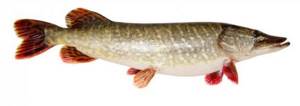
The predatory pike is familiar to everyone since childhood. She is widespread throughout Russia, so she is often found as a character in folklore. Fishermen also know many incredible stories about pike. It is believed that the largest pike was caught in the 15th century, in 1497. Her weight was 140 kg, and her body length was about 6 meters. It was possible to determine the age of the fish, since it was ringed. It was established that the mark corresponded to the era of the reign of Frederick the Second, ruler of the Roman Empire. The pike was ringed around 1230 and released. It turns out that she lived 270 years before she was caught by a person again. It is officially believed that the weight of pike reaches 16 kg.
Interesting: How do fish winter? Description, photo and video
Range yesterday and today
The fish lives in the Caspian, Azov and Black Seas. However, it swims into rivers to spawn.
The largest distribution of beluga is in the Caspian Sea; it spawns most often in the Volga River, but can also swim into the Terek, Ural, and Kura rivers. In small numbers, the fish swim to spawn in small rivers flowing into the Caspian Sea, near Azerbaijan and Iran.
Until now, beluga whales often swam several hundred kilometers or more along rivers, but now, after the construction of numerous hydroelectric power stations, their capabilities are significantly limited.
The Black Sea was quite teeming with beluga sturgeon, especially its northwestern part. Now the population has thinned out significantly for the same reasons - the construction of a hydroelectric power station (before construction, fishing could be very successful even in Kyiv and Belarus). The fish is found off the coast of the Caucasus; it also lives in the southern part of Crimea. Spawning most often occurs in the large rivers Dnieper, Dniester, and Danube.
Som
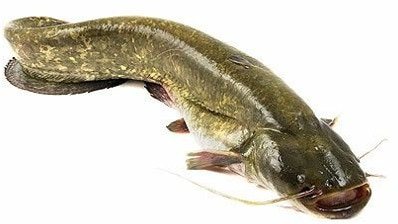
The most legendary fish, surrounded by many myths. Catfish are predators. Their diet consists of more than just small fish. Large old catfish can hunt ducks sitting on the water, animals that come to drink, and small pets. Catfish live a very long time and grow throughout their lives. They say that in the 19th century, in Russia, a catfish weighing 400 kg was caught. The officially registered catfish that was caught weighed 306 kg, was more than 3 meters long and was about 80 years old. Modern catfish weighing over 100 kg are extremely rare.
Interesting: The longest-haired cat breeds - list, description, photos and videos
Commercial value and problems of conservation of the species
Beluga has always been considered a commercial fish: its skin, caviar, and tasty meat were valued. Beluga caviar, which has a delicate nutty flavor, is considered the most valuable of all types of sturgeon caviar. It is a kind of delicacy and a relatively expensive pleasure. Meat, tough unlike others, but not fatty, is a dietary ingredient for introducing proper nutrition into the diet. Easily digestible proteins, amino acids that are not synthesized in the body independently and are obtained from food, trace elements and vitamins that strengthen bones and improve the condition of skin appendages (hair, nails) make it extremely useful for consumption.
The species of these fish has become so small due to constant fishing that it was listed in the Red Book of the International Union for Conservation of Nature - the beluga is recognized as an endangered species. Its fishery has practically become obsolete in natural conditions, but there are attempts to create artificial conditions for breeding. To do this, hybrids are created in artificial reservoirs by crossing sterlet and beluga - besters are obtained, which, for the purity of populations, are not released into the natural habitat. This underwater inhabitant looks like a mixture of both species.

Realizing how much beluga caviar or meat can cost, poachers stop at nothing. Illegally obtained products are punishable by law. The Azov beluga is listed in the Red Book of the Russian Federation. The value of caviar does not leave many poachers indifferent, which complicates the task of preserving the species.
lake salmon
Lake salmon
Lake salmon is not even a species or subspecies, but a morph of Atlantic salmon. Morph is a type of animal that has persistent differences within a species or population; this category includes melanists, albinos, local varieties, and so on. The main difference between lake salmon and Atlantic salmon is that they feed in lakes rather than in salt water bodies. The young of such fish do not go to the sea when they grow up; they live in the lake and then spawn in the rivers that flow into it. In Russia, such salmon live in lakes Ladoga and Onega, Segozero and a number of other northern reservoirs. Fishing is only possible within Lake Onega; the remaining populations are listed in the Red Book .
Lake salmon are smaller in size than sea salmon, with an average weight of 3-4 kg. The maximum officially noted is 7 kg, but fishermen claim otherwise, saying that they have caught fish weighing up to 10 kg or more. However, such statements should be treated with caution, because Baltic salmon, for example, also goes to spawn through Ladoga and Neva - rivers flowing into Lake Ladoga. And when switching to freshwater mode, the fish changes color; representatives of the oceanic stock are easily confused with “indigenous” freshwater inhabitants of larger sizes. Such individuals can also end up in Lake Onega, and a person may encounter an anadromous fish, considering it to be local freshwater.
Nutritional Features
Eating in a beluga or sturgeon has specific features that differ significantly depending on the age of the individual.
Important! This species is characterized by cannibalism, and it begins from an early age.
Being fry, they feed on plankton in rivers, eggs and fry of other small fish, which they usually find at the bottom. They are observed more often near river mouths due to shells with thinner shells than their relatives in the open ocean. From this we can conclude that the migration of these fish may be related to the location of food items. Grown-up young individuals are especially partial to the meat of young stellate sturgeon, sterlet or sturgeon. Juveniles, which in the process of development have swum from rivers to large seas, gradually change their diet: it already contains crayfish, mollusks, and small fish such as sprat or goby. Already at the age of two, a predatory lifestyle begins, feeding on fish of various stripes. The sooner they start eating large sea creatures, the faster they grow. It is noteworthy that in winter their meals become less frequent and sparser, i.e. the diet varies depending on the season.
Interesting! Beluga does not at all disdain eating its relatives; moreover, especially large representatives can eat some birds and seal pups.
The largest river fish in the world
The largest freshwater fish or river monsters are also widely represented in the rivers of other continents. Moreover, some of them are related to our Russian predators, for example, the American musky pike. It is also called the giant pike.
musky pike
The Muskinong is almost no different in appearance from our pike, but in size this predator is comparable to our pikes of previous centuries and long ago. External differences can only be found by a specialist or a person who knows these differences in advance. Firstly, the musky has no scales on the lower part of the gill covers and the edges of the caudal fin are sharper than those of our common pike. The muskie is distinguished by the sensory points that the lower jaw of the fish has. This pike has more of them than the Russian predator, most often over seven. Pike in our waters have no more than six. The color and stripes that turn into spots often coincide, especially if the conditions, that is, when the color of the water and soil also coincide in the American predator with the living conditions of our pikes.
Maskinongs can be up to 1.8 meters long and sometimes weigh 30-32 kg. But most often fishermen come across them with sports gear, so to speak, in the middle weight categories - 2.5 m long and weighing 16 kg.

Like our pikes, muskies prefer river bays with weak currents or standing water. The hunting objects of these predatory fish are also similar. Like the pikes of our rivers and lakes, muskellunges hunt fish and all living things that fit into their mouths: chicks, birds, frogs, crayfish, snakes, mice, muskrats.
The armored pike is also a relative of the pikes mentioned above, but rather a distant relative. It is also a serious fish that falls under the definition of being the largest freshwater fish.
Bull shark
But this is a real monster, which cannot be called a good fish, because, like all sharks, this predator is a real aggressor. The bull shark is found both in the vast expanses of the ocean and in the coastal zone. But this same shark can also be found in the most ordinary freshwater body of water: a river or even a stream, as long as the depth of this stream allows this powerful fish, which often reaches a size of more than 2.5 meters and a weight of 312 kilograms, to accommodate it. The insidious feature of such a shark is that it often stays in the shallow coastal waters of beaches and can be dangerous, as it is an aggressive and ruthless predator. This shark easily falls into the category of one of the largest fish in the world and can often be found in a series of photos of the largest river fish.

White sturgeon
The white sturgeon is also a giant fish and is the largest representative of the sturgeon family in North America. Moreover, this fish can be called the largest among freshwater fish of this continent. The largest individuals of this species reach a length of about 4 meters and these sturgeons weigh almost half a ton. These fish also differ in their life expectancy, which is 100 years or even more. Therefore, old fish, one can say without exaggeration, have seen a lot in their lifetime.

Nile perch
This is another relative of our domestic fish, or rather, perch, familiar to all “sailors”. Only the size of the overseas brother is impressive and awe-inspiring. As the name suggests, this “perch,” reaching a length of 1.8 meters and a weight of more than 180 kg, lives in the always muddy Nile River, and also in the rivers of Niger, Congo, and Senegal. Like our perches, the Nile perch has yellow eyes with black pupils. But the coloring of this perch is somewhat different, without stripes, instead of which the sides shine with silver with some bluish tints, which makes this seasoned predator very beautiful.
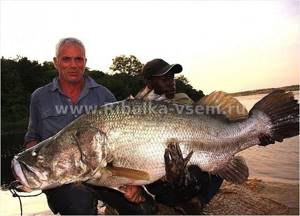
Alligator garfish
The largest river fish in the world are represented by another species that is truly a monster. This is an alligator garfish. The appearance of this monster is almost a copy of the alligator crocodile, at least that's what the head of the fish looks like. But, despite such a picturesque and fiercely aggressive appearance, these fish have never attacked people before, at least no such information has been received. These inhabitants of the water depths are also not offended by their size. Garfish alligators can weigh up to 140 kilograms with a length of 3 meters.
Arapaima gigantea
This is a fish that really deserves to be on the list - the largest freshwater fish. Specimens 3 meters long and weighing more than 68 kilograms are not uncommon in the waters of the Amazon. Confirmed data speak of arapaima weighing up to 200 kg. This is a fast and furious predator that not only manages to catch up and swallow fish, but also jumps to reach birds and small animals sitting in trees.
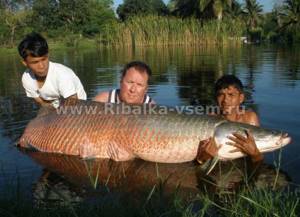
Arapaima can live in the most impassable swamps, where the water is very poor in oxygen. But this cunning fish has adapted to breathe atmospheric air, for which it needs to rise to the surface of the reservoir at certain intervals, which are about 20 minutes. The giant arapaima is protected by very dense and strong scales, but this did not save it from extermination by local native tribes, who from time immemorial caught this fish for food. These fish are now being protected and are likely to be farmed.
Interesting Facts
- Parents do not like to take care of their own offspring.
- When the beluga is about to spawn, it jumps to the surface of the sea surface to a decent height. This event has not yet received a scientific explanation from ichthyologists.
- This type of sturgeon does not have bones (like sharks, in principle). The replacement, in the form of cartilage, becomes stronger and harder over the years. Part of the chord - the vizig - can even be important in cooking. If the dish is placed in the oven whole, the vizigu is pulled out so that it does not spoil the presentable appearance of the fish. It is also used in the preparation of fish pies such as kulebyak.
- The Amur River basin is home to a related freshwater species, the kaluga. If you look closely at it in the photo, it is easy to notice minor differences with the beluga - the size of the mouth and the first bug on the back (they are larger). Scientists have repeatedly tried to cross both representatives with each other, but their efforts were unsuccessful.
Reserves and production
In the 1980s, the USSR occupied first or second place in the world ranking of fishing powers, annually producing 10–11 million tons of fish and other seafood. Now the Russian Federation is competing for fifth or sixth place with India, Peru and the United States, clearly leaving behind the industry leaders - China and Indonesia. In 2021, our fishermen produced 5 million tons of biological resources, including 4.7 million tons of fish. This year's results are expected to be approximately the same.
Article on the topic
The fish looks for where it is more expensive. Why do the gifts of our seas float to other countries? International fisheries, meanwhile, have made a big step forward in 30 years. Global catch increased by 17%, to 84 million tons at the end of 2021. And at the same time, resources decreased. According to the Food and Agriculture Organization of the United Nations, in 2015 the proportion of fish stocks exploited beyond the limits of biological sustainability reached 33%. Among several areas that rampant fishing threatens to leave without fish, there is one within our borders - the Black Sea. But could his problems have sharply reduced the all-Russian catch? It turns out not.
“Last year, the Azov-Black Sea basin gave the Russian Federation only 1.5% of the production of aquatic biological resources. The share of the Baltic and the Volga-Caspian basin is also small, said Nikolai Antonov, head of the department of the All-Russian Research Institute of Fisheries and Oceanography (VNIRO). — 14% of our fish is caught in the European north. The main contribution—82%—comes from the Far East.” And at the same time, the Seas of Okhotsk and Bering are among those whose reserves are the most stable.
It is very difficult to count the fish stock hidden in the water column. The situation is constantly changing. Therefore, VNIRO scientists regularly forecast only the raw material base of fisheries - how much can be caught in the coming year without damage to the population. The forecast for the Russian seas and the Baikal basin for 2021 is 4.5 million tons. And the total biomass can be called approximately. Today it is around 45–50 million tons. The most caught are pollock, herring, salmon, and cod—fish whose reserves are the largest (see infographic).
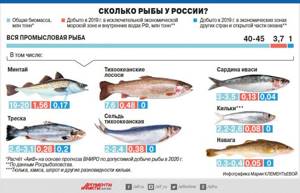
Click to enlarge
Official documents
The largest and hardiest fish of this species are found in North America and are called musketeers. As already noted, the largest pike caught in the world was caught in Lake Ilmen, and the largest muskie was caught in 1957 in the St. Lawrence River, and it weighed 32 kilograms. The largest common pike caught in the United States pulled 25 kg. And they caught her in 1940. It’s strange, there is a photograph of a pike caught in Ilmen, there are data described, and yet when asked how much the largest pike in the world weighs, the answer is just over 25 kg. It should be added that in 1979, a cadastral book was established in England, in which all large pike caught exceeding a weight of 14 kilograms were recorded.
Ocean perspectives
“Russia uses 80% of the raw material base of its waters. The only fish not harvested are those whose fishing is unprofitable and which is not suitable for processing. To increase the catch to the Soviet level, it is necessary to enter the World Ocean and the zones of other countries, says Antonov. “Now, outside its jurisdiction, the Russian Federation takes only 20% of the annual catch.” In 2021, we harvested all Atlantic herring, 90% of mackerel and 40% of cod from outside our waters. But this fish is caught under an agreement with Japan and Norway near the Russian borders. Only ships that take sardines and sardinella off the coast of Morocco go on long ocean expeditions.
“Soviet fishermen caught the bulk of their catches in international waters. The numbers reached millions of tons,” says German Zverev, president of the All-Russian Association of Fisheries. — The decrease in this production occurred due to the cessation of state subsidies for expeditionary fishing in remote areas of the World Ocean. He eventually stopped. Today in Russia, funding for scientific research aimed at studying the state of fish stocks in these areas is annually reduced. Moreover, most of the resource base is located in the Pacific Ocean. In its southern part there are horse mackerel, squid, krill, in the northern part there is saury. In September 2021, a national program for the development of the Far East until 2035 was adopted. In our opinion, it should contain measures for state support of expeditionary fishing in the Pacific Ocean. We are preparing our proposals and calculations in this regard.”



